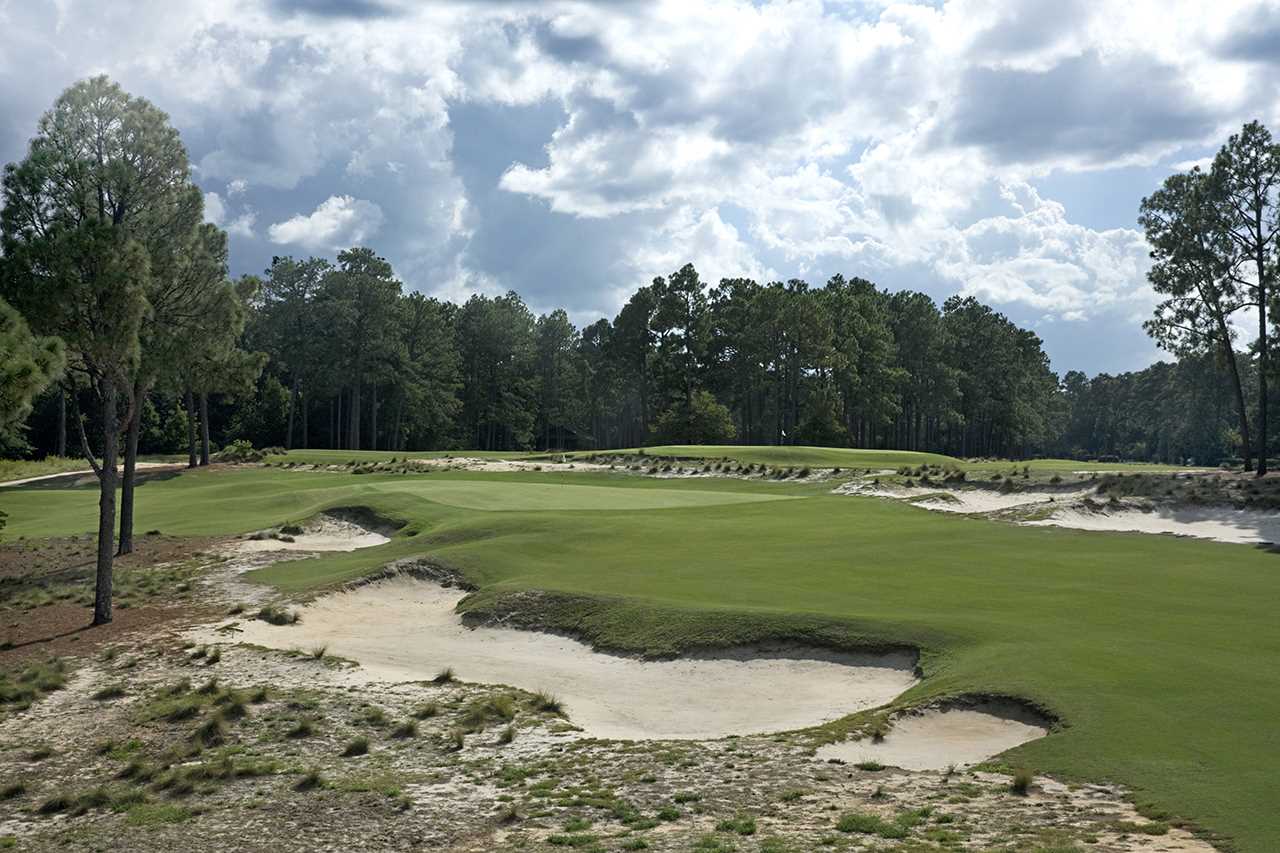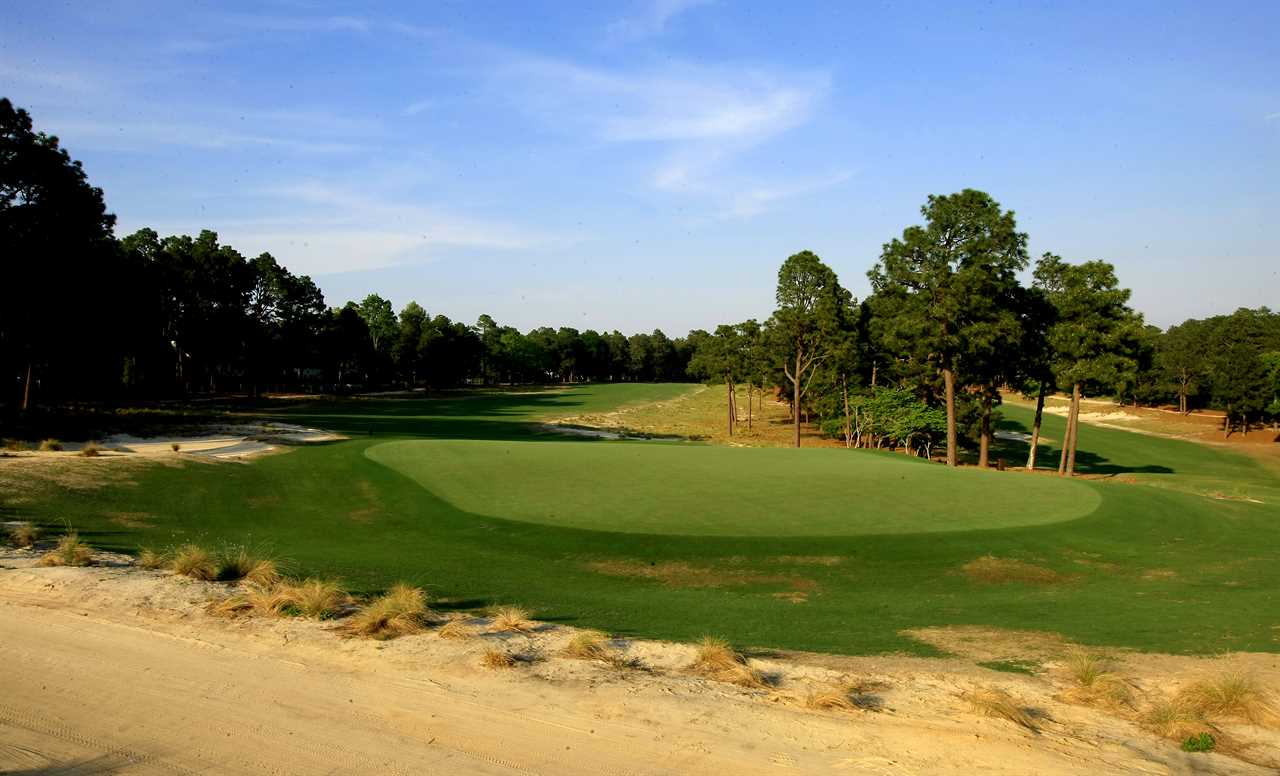PINEHURST, N.C. — They say there’s never a bad day at Pinehurst, especially if you’re walking around course No. 2, the famed masterpiece of renowned architect Donald Ross.
The gem in the sandhills of North Carolina will play host to its fourth U.S. Open next summer (1999, 2005, 2014), and the folks at the United States Golf Association recently held an early preview for its flagship championship.
“We are comfortable that Pinehurst will provide the test of golf that has always provided,” said course setup lead Jeff Hall. “If Martin Kaymer hadn’t entered in 2014 we’d have had a really competitive championship, but he played brilliantly.”
“We’re not trying to play defense with the players,” he added. “This golf course, when it’s firm and fast, you can have some scary wedge shots. Even if it was shorter, there’s still some pretty scary wedge shots here.”
From fairways and tricky greens to new grass and hospitality venues, here’s what players and fans should expect to see when they step on the property for the 2024 U.S. Open, June 13-16, at Pinehurst No. 2.
No. 2 will look and play as it was designed
When Pinehurst worked with Bill Coore and Ben Crenshaw to restore the course in 2010 and 2011, the team removed 35 acres of Bermuda rough and replaced it with nearly 250,000 wire grass plants so the course would look and play the way Ross originally intended. To get it as close as possible, images from 1948-1962 were used.

Pinehurst No. 2 in North Carolina (Courtesy of Pinehurst Resort)
No. 2 is a unique test of golf for a U.S. Open due to its sandy areas in lieu of ankle-deep rough. If players miss the short green grass, they’ll have to deal with the elements. Fairway widths are 34-45 yards at No. 2, which differs from, say, Winged Foot or The Country Club where 24-32 yards is the norm. The diabolical turtleback putting greens make fairway placement all the more important.
“Thinking back to 2014, this was a really difficult U.S. Open to play,” said former Tour pro and current USGA Senior Director of Player Relations Scott Langley. “I say that as a guy who finished in 63rd place, wasn’t as difficult for Martin Kaymer. The thing that’s difficult about Pinehurst No. 2 is the putting greens and surrounds. The greens are very difficult to hit, so you’re often faced with a variety of shots around the greens to recover.”
When you think of a missed green at a U.S. Open, tall, lush rough comes to mind. At Pinehurst, you can play any number of clubs to get up and down to save par. Bump-and-run with an iron. A perfectly nipped wedge. Maybe a hybrid instead of a putter. The course allows for a certain level of creativity that most championship venues lack. It introduces uncertainty for players, which is when things get interesting.
“It provides a mental challenge as much as a physical one,” added Langley. “No matter what club you end up choosing or what shot you decide to play, you always have a little bit of doubt in your mind if it’s the right one because of the presence of so many options.”
As if golf wasn’t hard enough already. But that’s why it’s the U.S. Open, known as the toughest test in golf.
Key corner of the course
If you’ve been to No. 2, you’ll know the area on the front nine that features No. 3 green, No. 4 tee, No. 5 green and No. 6 tee. Come next summer, the section of the course will be a fan-favorite to watch a lot of golf, especially if No. 3 is drivable.
The short par-4 3rd hole is gettable no matter where the tee is, but the challenge increases with the sloping fairway of the par-4 4th. Players will get a breather with the par-5 5th before they’re faced with arguably the toughest test of the front nine, the tricky par-3 6th hole.

The fifth hole on Pinehurst No. 2. (Photo: Tracy Wilcox/Golfweek)
In 2014, Martin Kaymer played No. 3 and No. 5 at 6 under par and finished the championship at 9 under. He drove the green on No. 3 on both days the tee was up and two-putted for birdie. He played No. 5 at 4 under thanks to a pair of birdies and an eagle.
“You could hear some roars in this part of the world,” Hall predicted.
When it comes to set up and yardage tee to green, the course will be very similar to what fans and players saw in 2014. The real difference is the surface of the putting greens. The 2014 championship and all the previous championships (as far as the USGA knows) were played on bentgrass. The 2024 championship will be played on Bermuda grass.
The change from Creeping Bentgrass to Ultradwarf Bermuda grass provides a different perspective for the tournament crew when preparing for a U.S. Open.
“It gives us a lot more flexibility because the temperatures are ramping up, nighttime, daytime, sunlight, everything that works against the cool season grasses that time of year are in our favor for the Ultradwarf Bermuda grass,” said Pinehurst superintendent John Jeffreys.
“It allows us more options for managing firmness,” added Darin Bevard, Senior Director of Championship Agronomy. “I just hope that Mother Nature cooperates in June that we’re having this conversation about firmness and not about fixing wash outs and bunkers. We really hope for a firm and fast U.S. Open come June.”
Outside the ropes
The course is a masterpiece inside the ropes, but the USGA believes the same to be true outside the ropes. The resort is an ideal venue logistically, and the staff has a proven plan for what works and what doesn’t.
In order to improve on past successes, the USGA is keying in on two aspects: getting fans closer to the action and elevating the overall fan experience. The answer is different product offerings from the gallery ticket all the way up to the most premium hospitality stand.
A grandstand left of the 18 green with the clubhouse in the background has been a staple for U.S. Opens at Pinehurst. Next year, the grandstand will be integrated with a premium hospitality experience called the 1895 Club, the highest-end experience on-site. The club comes with valet parking, shuttles, and the best food and beverage offerings with the 18th green as entertainment.
“That’s certainly going to be something we’re excited about and something that’s going to feel and look very different,” said Leighton Schwob, the USGA’s Senior Director of Operations.
Pinehurst is going through a full renovation of the lower floor of the resort building, which is where a lot of player facilities will be. A tunnel from the locker room up to the first tee for players is also being built and should be completed by the end of the year. The resort’s driving range will be more of a fan area next summer, as the USGA anticipates more than 250,000 fans will be in attendance for the week.
The course will shut down near Memorial Day, but facilities will be built beginning in March. So don’t fret, there’s still plenty of time to go play before the pros.
https://golfweek.usatoday.com/2023/10/31/early-preview-2024-us-open-pinehurst/
 Backyard GrillingWeekend WarriorsAdvice from DadBeard GroomingTV Shows for Guys4x4 Off-Road CarsMens FashionSports NewsAncient Archeology World NewsPrivacy PolicyTerms And Conditions
Backyard GrillingWeekend WarriorsAdvice from DadBeard GroomingTV Shows for Guys4x4 Off-Road CarsMens FashionSports NewsAncient Archeology World NewsPrivacy PolicyTerms And Conditions
